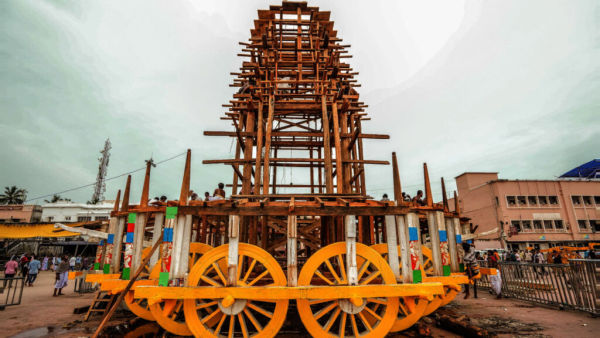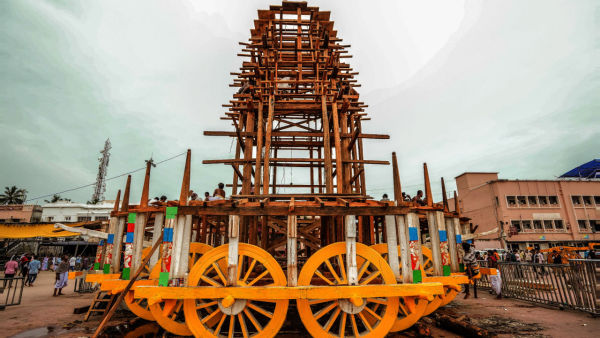

New Delhi: Jagannath Yatra, or Puri Rath Yatra, is one of the oldest and biggest rath yatras in the world. The Puri Rath Yatra this year will begin on Friday, June 27. This timeless tradition, steeped in centuries of faith, celebrates the journey of Lord Jagannath, accompanied by his siblings Balabhadra and Subhadra, as they make their annual visit to the Gundicha Temple.
More than a ritual, the yatra is a symbol of unity, devotion and divine grace. During the festival, three siblings are drawn by devotees on massive wooden chariots down Bada Danda to Gundicha Temple. The chariots are decorated according to a centuries-old scheme. Read on to learn more about the three chariots.
The three chariots of Jagannath, Balabhadra and Subhadra are made new each year from specific types of wood like phassi and dhausa. These trees come from the former princely state of Dasapalla, brought by skilled carpenters who have special rights to do this. The logs float on rafts in the Mahanadi River, are collected near Puri and then are transported by the road.
Each year, the chariots are decorated according to a unique tradition that has been followed for centuries. They are displayed on the Bada Danda, the Grand Avenue, in front of the temple near its eastern entrance, known as the Singhadwara or Lion’s Gate.
Each chariot features nine Parsva devatas, which are painted wooden images of various deities on the sides. Each chariot has a charioteer (Sarathi) and is pulled by four horses.
Lord Jagannath’s chariot is called Nandighosa. It stands 45 feet tall and is 45 feet square at the level of the wheels. It has 16 wheels, each measuring seven feet in diameter and is covered with red and yellow cloth. Lord Jagannath is identified with Krishna, also known as Pitambara, and this is reflected in the yellow stripes on his chariot’s canopy.
The Charge Balabhadra, named Taladhwajabears a Palm Tree on its flag. It has 14 wheels, each seven feet in diameter and is covered in red and blue cloth. Its height is 44 feet.
Subhadra’s Chariot, Called Darpadalanameans trampler of pride. It is 43 feet tall and has 12 wheels, each seven feet in diameter. Its covering is made of red and black cloth, with black symbolising Shakti and the Mother Goddess.
Each chariot is accompanied by nine Parsva devatas and four horses of different colours: white for Balabhadra, dark for Jagannath and red for Subhadra. The charioteers are Matali for Jagannath, Daruka for Balabhadra and Arjuna for Subhadra.
| Chariot Details | Jagannath | Balabhadra | Subhadra |
| Name of Chariot | Nandighosha | Tallwaja | Darpadalan |
| Alternates name of Chariot | Gruddhaja, Capi’s Capidate | Langaladhwaja | Devadalana, Padmadhwaja |
| Number of wheels | 16 | 14 | 12 |
| Total Number of wooden pieces used | 832 | 763 | 593 |
| Height | 45 | 44 | 43 |
| Length and breadth | 34’6″ x 34’6″ | 33′ x 33′ | 31’6″ x 31’6″ |
| Colours of the canopies | Red, Yellow (yellow associated with Vishnu) | Red, Bluish green | Red, Black (Black associated with the Goddess) |
| Guardian | Garuda | Vasudeva | Jayadurga |
| Charioteer | Daruka | Represent | Arjuna |
| Flag name | Trailokyamohini | Unnani | Nadambika |
| Flag emblem | Palm Tree | ||
| Name of Horses | Shankha balahaka shweta haridashwa | Tibra ghora dirghasharma swarnanava | Rochika Mochika Jita Aparajita |
| Colour of Horses | White | Black | Red |
| Name of Chariot Rope | Stylish Nagini | Basuki Naga | Swarnachuda nagini |
| Accompanying deity | Wife | Ramakrishna | Sudarshana |
| Gatekepers (Dvarapala) | Jaya vijaya | Nanda Sunanda | Ganga Jamuna |
| Nine parshvadevata (subsidiya deities) | Panchamukhi mahabir (hanuman) Harihara Madhusudana (Vishnu) Giridhar (Krishna) Pandu Narasingha Chintamani krishna Narayana (Vishnu) Chatra bhanga rabana (rama) Rama seated on Hanuman |
Ganesha Karties Sarvamangala Pralambari (Balarama) Halayudha (Balarama) Mrityunjaya (shiva) Natamvara (Shiva) In Ketwar (shiva) Sheshadeva |
Chandi Gardens Ugratara Banadurga (Durga) Shulidur (Durga) Varahi Shyamakali Mangala Vimala |
Carpenters and servitors construct wheels for the chariots of Lord Jagannath, Balabhadra and Devi Subhadra (Photo credit: PTI)
Construction of wheels for the chariots of Lord Jagannath, Balabhadra and Devi Subhadra (Photo credit: PTI)
Construction of Chariots of Lord Jagannath, Balabhadra and Subhadra (Photo Credit: PTI)
Artisans busy for the construction of chariots for Lord Jagannath, Balabhadra and Devi Subhadra (Photo credit: PTI)
Artisans work for the construction of chariots (Photo credit: PTI)
The main rituals of the Jagannath Rath Yatra will take place on June 27, 2025, in Puri, Odisha. Key timings include Mangala Aarti at 6 am, Pahandi Bije (procession to the chariots) from 1.10 pm to 2.30 pm, Ratha Pratista (chariot consecration) at 11 am and chariot pulling at 4 pm.